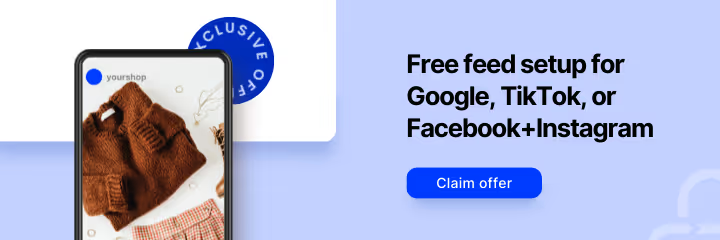There are many factors that go into making a sale: product placement, pricing, company reputation… just to name a few. When it comes to ecommerce sales, however, there’s one thing that is absolutely essential: your data feed. If your sales are slowing down -- or you're having trouble getting any sales to begin with -- it may be time to take a step back and give your data a nice, big audit.
Sounds fun, right? Don’t worry, we’ve broken it down for you to make the process as painless as possible.
1. Do you have a centralized place where your data is stored?

Before we get into the nitty-gritty of the data itself, let’s take a step back and talk about where your product data lives. If you have a website, then your product data probably lives on an ecommerce platform such as Shopify or Magento. But exporting that data, editing it to meet channel standards and manipulating it with optimization tricks can turn into managing multiple spreadsheets (and one big fat headache).
This is where a data feed management software can come into play. This way, your data can live in one centralized place where it can be easily manipulated and sent out quickly to other channels.
The ability to make quick changes means that you can also make more frequent changes. This comes as an advantage when trying to test data attributes such as price changes in a feed. Same goes for testing title optimization formulas. If one keyword isn’t working you can swap it out for another keyword in a few clicks and the data feed management tool takes care of making those updates across the board.
Having one place to go to for feed edits can make the process of data feed management a whole lot easier and more efficient.
2. Are your titles search-friendly?

Product titles that work well on your website may not go over so well with your product listings. The reason? Context. Think about it. Shoppers who are browsing your site probably already have a general idea of what you sell. When it comes to browsing different listings, that’s just not the case. For example, if your sneaker website lists a product as ‘Nike Zoom Fly’, shoppers will likely know what you are selling. If they see that title on Amazon or Google, that may not be the case. And that wouldn’t work so well for search queries.
To increase the likelihood of your product showing up in search, you’ll have to think like your customers. What keywords are they likely to use in their search? What attributes are most relevant to your target shoppers?
And let’s not forget that the order of the keywords matter when it comes to Google, as they put more weight on keywords listed in the beginning of the title.
Here is an example formula for apparel products:
Brand + Gender + Product Type + Attributes
If you are selling a Topshop shirt, your title may go something like ‘Topshop Women’s Crop Tee - White.’
Titles aren’t just important to Google. Amazon even provides formulas for each category that sellers can follow when creating their titles.
Do your research when it comes to keywords to find the most relevant ones for your potential customers.
3. Are your descriptions informative enough?

Next up are those product descriptions. I’ve seen many cases where sellers don’t have a description for their product and use the title in its place. In more instances than not, the title just isn’t informative enough to drive a purchase.
If a shopper is reading your listing description, they are trying to determine if the product is right for them. That’s why you need to add details that could help sway a purchase. This includes the top product features and usages. Also, attribute information such as dimensions, material, and style can be useful.
A great way to develop content is to use commonly asked questions about your product. If you are receiving the same question over and over again, it’s likely that other shoppers will want to know the answer as well. For example, if your selling wireless headphones and shoppers keep asking you how long the battery lasts, this may be an important detail to add to your listing.
Common and uncommon product uses are also good to cover for SEO purposes. Put yourself in your customer’s shoes. What will they be using your products for? Are there some other uses for this product besides the obvious? Be sure to cover all uses to ensure no shopper is left behind.
The description is another place where you will want to add relevant product attributes and keywords. Think about adding in synonyms, similar phrases, and colloquialisms. This can increase the chance of your product coming up in a search. A tool like AdWords Keyword Planner can help you determine what keywords to target.
Besides having a place for the description, Amazon also has the key product features section where you can highlight the most important product attributes and features in bullet point format.
4. Are your images optimized for each channel?

Going in and out of feeds and merchant center accounts on a day-to-day basis has exposed me to many of Google’s infamous Merchant Center error messages. One of the more common ones that I’ve been seeing is that the image is too small. Google requires that apparel products have an image of at least 250 x 250 pixels but not larger than 64 megapixels. For those non-apparel products, the image must be 100 x 100 pixels and no larger than 64 megapixels.
One of Amazon’s main image requirements is that the main image on the product detail page must be on a pure white background.
Moral of the story is that each channel has their own set of image requirements that you must abide by to avoid errors and headaches.
Once your image meets the necessary requirements for each channel, you’ll want to focus on optimization. Since online shoppers don’t get to see or feel the actual products, they rely heavily on the images to give them the product experience. In fact, 78% of shoppers online want to see more images from ecommerce sites. That’s why it is key to provide them with multiple high resolution images that shows your products at different angles.
Another good image would be to show how your product looks when being used. For example, if you’re selling a decorative end table, you may want to show how this product will look in a living room setting.
For some channels -- such as Facebook -- you will need an image that stands out from the busyness of the Facebook news feed. Colorful action shots can be a way to catch the consumer's eye and encourage them to click on your ad to find out more about the product.
So we recommend splurging on a professional photographer or a good camera to get those images just right.
5. Do your products require GTINs/UPCs?

Global Trade Item Numbers (GTIN) are used to uniquely identify products. Let’s do a quick refresher on the different types of GTINs:
- UPC (12 digits) used in North America
- JAN (8 or 13 digits) used in Japan
- ISBN (13 digits) used for books
- ITF-14 (14 digits) used for multipacks
Last year, Google made some serious changes regarding GTIN requirements in what looked like an attempt to standardize data. GTINs are now required for all products where a GTIN is assigned by the manufacturer. So if you don’t know your products GTIN information, it’s time to find out.
While there are some instances where mpn and brand are all that is needed for a successful submission to Google, this has more or less become the exception. If you haven’t logged into your Merchant Center account in a while to review, we suggest doing so to ensure your products are error free in regards to GTINs.
If you haven’t had to use GTINs in the past and are looking to expand to other channels -- like Walmart -- you’ll want to start using them now because they are required.
Where can you find your product’s GTINs? Check your product’s packaging or book cover for the number before the barcode.
If you are having issues locating them, reach out to your product’s manufacturer.
6. Are you priced competitively?

Price is usually a major deciding factor when it comes to making a purchase. If your product isn’t selling well, it’s possible that it isn’t priced correctly.
Take advantage of discounted pricing on Amazon and promotions on Google. After all, shoppers love the feeling that they’ve gotten a steal on a product. It could also create a sense of urgency for the shopper in fear that they might lose out on the deal.
Walmart is known for its low prices. They will automatically take certain products down if they have ‘highly uncompetitive’ prices.
So what exactly does that mean? If you are offering the same item on a competing website for a lower price, including the cost of shipping, expect your product to be taken down. While that one is more in your realm of control, the one you really need to watch out for is if a customer can purchase your item on a competing website for a lower cost regardless of who is selling it. That means that if your competitors are offering this product for a lower price somewhere, expect yours to be taken off of Walmart. To prevent this from happening, you’ll want to be sure you're keeping tabs on your competitor's pricing and adjusting yours accordingly.
Now let’s talk about pricing strategies. Here in the ecommerce biz, we know just how important seasons are and like to capitalize on them. If you are selling products that are more popular in certain seasons, you may want to consider a seasonal pricing strategy. This goes back to the basic laws of supply and demand. When a product is in season, more people want it and are, therefore, willing to pay more for it.
A good example for this would be skis. At the start of ski season around November, more people will be in the market for skis for their upcoming trips. Therefore, that would be a good time to raise those ski prices on marketplace channels. As mentioned above, this may not work for some channels that are stricter about pricing ( like Walmart). This is where having a data feed management tool, which gives you the ability to easily make pricing changes by channel, saves you lots of time and hassle.
7. Are you updating your feed frequently enough?

Have you recently received errors from Google for your price or availability not matching what is on your website? How about on Amazon, are you overselling products? Are your price changes not reflecting quickly enough? If any of these are true, then you may be guilty of not updating your product feed frequently enough.
Infrequent feed updates can lead to inaccurate data on your listings, which can lead to errors or penalties from the channel you are selling on.
Talk to your team to determine how often important details such as price and quantity change and then realistically decide how often you should be sending your feed to the designated channel. This is where an automation software comes in handy. You can simply set additional submission times instead of manually updating feeds or listings.
8. Are your products categorized correctly?

The category that you place your product in can play a factor in whether you appear for your desired searches. Google makes it known in its help center that the categorization of your products help them better connect your ads with search queries from shoppers. If you are simply throwing all of your home products into the “Home & Garden” category, you aren’t doing your product catalog any justice and can be missing the bar when it comes to potential sales.
Take the time to review your current categorization and update it to be as specific as possible.
9. Are you selling on the right channels?
Different channels work better for different product types and price points. If a specific channel is not delivering results after you’ve implemented optimization strategies (and given it enough time for those optimizations to bear fruit), it’s possible that this channel just may not be a fit.
While it is important to eliminate channels that just aren’t working, it’s still crucial to implement a multichannel strategy. By diversifying the channels you sell on, you are able to reach more shoppers and, in turn, more traction and sales.
While it’s crucial to have your products on the major channels (Amazon, Google, Facebook, eBay, etc.) they can be saturated with competition and you have to work harder to succeed. If you have the right products, selling on a smaller channel focused on fewer product types can prove beneficial.
If you are a clothing retailer, consider social selling via Meta, TikTok, Snapchat, and Pinterest. If you’re in home and garden, take a look at Houzz and Amazon. Google PMax Shopping ads are great for tech products with higher price tags.
The point is, don’t just settle for the broad reach of the major channels. Define your audience and then find targeted channels that fit your needs.
Conclusion
As you can see, managing data feeds and product listings takes some serious work. You can’t just send a data dump to multiple channels and expect the sales to flow in. To have a successful feed, it’s important that you continuously review your feeds to avoid common pitfalls and continue making improvements.
Remember: You’re not alone. If you have any questions on how to more efficiently manage your data feed, we’re here to help.






%20).webp)